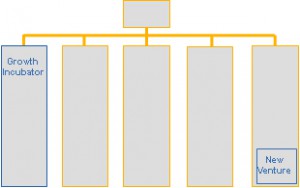A model for driving sustainable innovation within a mature business
How do you foster innovation within the context of a large, mature business? “Main street” businesses that serve established markets face a daunting challenge: managing and growing the core business while concurrently nurturing and supporting new business opportunities
Organizations designed for large scale production and delivery are typically poor parents for internal new ventures. Starved resources, inflexible infrastructure and support structures, and inconsistent sponsorship that ebbs and flows based on the health of the larger organization are symptoms of a broader problem – the fact that established enterprises are inherently designed using metrics, processes, and reward systems suitable for mature businesses, not for fast-moving start-ups.
Ambidextrous organization designs create distinct units that have their own unique processes, structures and cultures that are specifically intended to support early-stage innovation. These units, often comprised of one or more innovation teams, reside within the larger parent organization but have been set up to support the unique approaches, activities and behaviors required when launching a new business.
Executive leadership can use the ambidextrous organizational model to create segregated business units for exploring and developing breakthrough innovations (products, services and processes) while at the same time keeping existing business units in tact. Project teams within the new venture are encouraged to form their own processes, structures and cultures but they are still connected to the rest of the organization through executive sponsors who ensure that no organizational conflicts or competition for resources threaten the viability of the venture.
The following figure illustrates two different ambidextrous models. The first is a “growth incubator” that stands alongside enterprise business units. New opportunities are identified, developed and brought to market by the incubator and either spun out as new business units or folded back into existing units. Alternatively, a business unit itself may create an ambidextrous organization by establishing and protecting a new venture within its own walls.
To develop an ambidextrous organization, leadership must possess the ability to attend to already existing products, services, business models and processes while simultaneously supporting the innovations that will drive the organization’s future. Ambidextrous design and management ultimately means continuing to oversee the core business while concurrently protecting the emerging venture as it evolves and grows.


